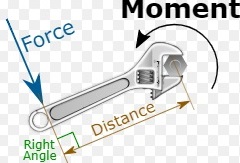Moment
In terms of physics, a moment is the product of a physical quantity and a certain distance, and is usually defined with respect to a fixed reference point. Generally, a moment can be produced by any physical quantity that is multiplied by distance, with commonly-used quantities including force, mass, electric charge, and so on.
The moment of force that acts on an object, known as ‘torque’, is a measure of its tendency to cause the object to rotate about a specific point or axis, and is the product of the force and its distance from the point or axis.
Moment (M) = force (F) x distance (d)
For a moment to develop, the force must act in such a manner that the object begins (or would begin) to twist; in other words, when the force does not have an equal and opposite force directly along the line of action. For example, if two people are stood on opposite sides of a door and both are pushing on it with an equal force then there is equilibrium. If one person stops pushing then there would be no opposing force and the person still pushing would have created a moment of force.
The fixed reference point is also known as the ‘centre of moments’. This can be the actual point about which rotation occurs due to the force, or the axis about which the force may be considered as causing rotation.
A bending moment (BM) is a measure of the bending effect that can occur when an external force is applied to a structural element. This concept is important in structural engineering as it is can be used to calculate where, and how much bending may occur when forces are applied.
For more information see: Bending moment.
[edit] Related articles on Designing Buildings Wiki
Featured articles and news
Government consultations for the summer of 2025
A year of Labour, past and present consultations on the environment, the built environment, training and tax.
CMA competitiveness probe of major housing developers
100 million affordable housing contributions committed with further consultation published.
Homes England supports Greencore Homes
42 new build affordable sustainable homes in Oxfordshire.
Zero carbon social housing: unlocking brownfield potential
Seven ZEDpod strategies for brownfield housing success.
CIOB report; a blueprint for SDGs and the built environment
Pairing the Sustainable Development Goals with projects.
Types, tests, standards and fires relating to external cladding
Brief descriptions with an extensive list of fires for review.
Latest Build UK Building Safety Regime explainer published
Key elements in one short, now updated document.
UKGBC launch the UK Climate Resilience Roadmap
First guidance of its kind on direct climate impacts for the built environment and how it can adapt.
CLC Health, Safety and Wellbeing Strategy 2025
Launched by the Minister for Industry to look at fatalities on site, improving mental health and other issues.
One of the most impressive Victorian architects. Book review.
Common Assessment Standard now with building safety
New CAS update now includes mandatory building safety questions.
RTPI leader to become new CIOB Chief Executive Officer
Dr Victoria Hills MRTPI, FICE to take over after Caroline Gumble’s departure.
Social and affordable housing, a long term plan for delivery
The “Delivering a Decade of Renewal for Social and Affordable Housing” strategy sets out future path.
A change to adoptive architecture
Effects of global weather warming on architectural detailing, material choice and human interaction.
The proposed publicly owned and backed subsidiary of Homes England, to facilitate new homes.
How big is the problem and what can we do to mitigate the effects?
Overheating guidance and tools for building designers
A number of cool guides to help with the heat.
The UK's Modern Industrial Strategy: A 10 year plan
Previous consultation criticism, current key elements and general support with some persisting reservations.
Building Safety Regulator reforms
New roles, new staff and a new fast track service pave the way for a single construction regulator.

























